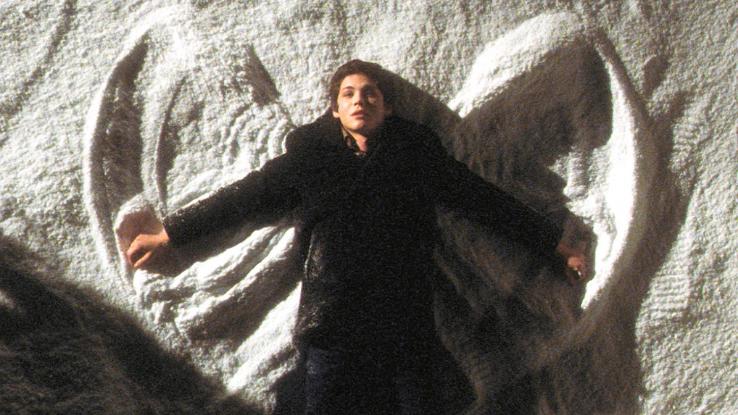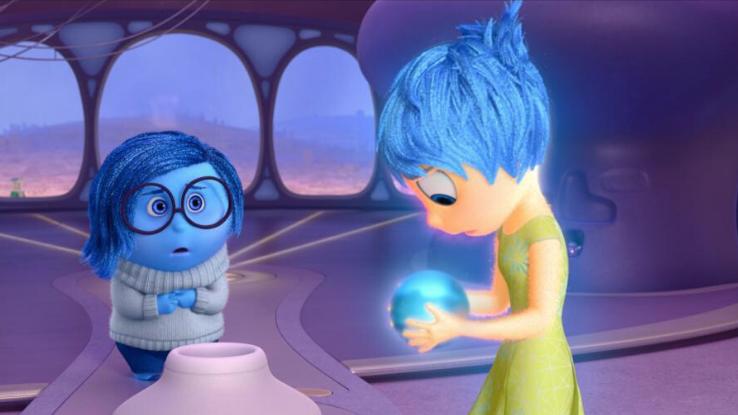Audio Post Production for Film and Tv Berklee Review

The mod world places a cracking deal of importance on physical wellness, emotional wellness, and even financial wellness. When it comes to mental wellness? Not so much. Understanding the litany of mental illnesses that exist in our communities is just equally valuable as understanding who'south function of the Fortune 500. Centuries agone, mental illnesses were attributed to nighttime magic or malevolent spirits. So once again, our ancestors lacked one-half of the knowledge and resources that we accept. Misconceptions regarding mental health and mental illness have no reason to persist.
Then, how does popular entertainment effigy into this discussion? Information technology's no secret that representation matters. Seeing accurate, nuanced depictions of mental illness and disorders not just helps folks living with those illnesses, disorders, and conditions feel seen, merely such portrayals of real-life experiences can exist a way to educate, build support, and dispel harmful misinformation. Not to mention, it can help folks feel less ostracized.
However, co-ordinate to a study conducted by the USC Annenberg Inclusion Initiative (USC AII) and published in May 2019, "Out of 4,598 speaking characters across the 100 meridian films of 2016, only 76 [or 1.7%] were depicted with a significant or persistent mental health condition." As the written report points out, this is a stark contrast with our reality: roughly 20% of adults in the U.South. alive with a mental health condition and/or mental illness. Without a doubtfulness, fine art has the propensity to dismantle stigma and stereotypes surrounding mental affliction — and it'due south well-nigh time moving-picture show and television harness that potential.
Editor'due south Annotation: This commodity contains mentions of various mental illnesses and mental wellness disorders as well every bit discussions of how some of these illnesses and disorders are portrayed, both accurately and poorly, in movie and TV. Additionally, while the films and Tv set shows at the finish of the commodity depict mental illness and mental wellness disorders accurately for the nigh part, information technology's important to note that these depictions may not resonate for some readers every bit everyone's experience with mental illness and mental health disorders is nuanced and specific.
Why Is It Important to Accurately Depict Characters With Mental Illness?
In both mediums, mental wellness is often stigmatized, used as a plot device, or trivialized — yous know, made into a character "quirk" instead of existence taken seriously. The aforementioned study constitute that, of 87 picture show characters who have mental health conditions or mental illness, 47% of characters were disparaged; 22% of characters' mental wellness conditions or mental disease were met with sense of humor; and 15% of characters felt the need to conceal their mental health condition or mental illness.
Moreover, when characters with mental illness are portrayed on screen, 46% of them were institute to exist perpetrators of violence. Regardless of intention, most films and shows unfortunately normalize name-calling, with characters slinging words like "psycho," "crazy," "freak," "dizzy," "basics," "weird" and "monster" at other characters who outwardly express a mental wellness condition or illness.

The study also shows that when in that location is representation, it's not reflective of well-nigh audition members' identities or experiences. For case, while twenty% of teenagers in the U.Due south. experience a mental health status, simply 7% of motion-picture show characters (of that 87) were teens.
Moreover, Mental Health America found that 6.8 million Black Americans report having a diagnosable mental disease, only, despite this fact, only 11 of the characters with mental health conditions surveyed by USC AII were Black. This trend of underrepresentation continues for all people of color: Only four of the characters in the survey were Asian; only ane grapheme was multiracial; and none of the characters identified equally Hispanic, Latinx, Center Eastern, Native Hawai'ian or Pacific Islander, or as Ethnic or First Nations peoples.
Additionally, the National Alliance on Mental Illness (NAMI) has constitute that LGB adults are more than twice as likely every bit straight adults to feel a mental health condition. Non to mention, LGBTQ+ people are at a college risk than cis and/or straight folks for suicidal thoughts and suicide attempts. But portrayals of mental illness oft leave out the LGBTQ+ community as well. Out of 50 TV shows surveyed by USC AII, merely viii LGB characters experienced mental health atmospheric condition, while the transgender community wasn't represented at all. And, out of 100 films, none of the characters with mental health conditions identified every bit being function of the LGBTQ+ community.
All of this is to say that, in addition to stigmatizing mental affliction, on-screen depictions frequently don't account for the multifaceted experiences of most folks, nor do these depictions account for the way the aspects of an individual'southward may intersect. In fact, at that place'due south hardly whatsoever accounting for diverseness in race, gender or sexual orientation at all, nor is in that location an attempt to empathize how those intersections of identity may interact with mental wellness conditions or illness. So, how tin creators work toward more authentic, nuanced and safe portrayals of mental illness?
Common Onscreen Faux Pas When It Comes to Depicting Mental Affliction
In order to shift how stories portray characters with mental health weather condition and mental illness, USC AII suggests that writers ask themselves a very primal question: Why am I telling this story? This can help creators avert mutual pitfalls, like depicting unnecessary stigma, using a mental health condition as a plot device, and/or making mental illness into the punchline. To be frank, the lived experiences of folks who take mental health conditions and illnesses are missing from popular civilisation.
And, when these experiences are depicted, they're often displayed irresponsibly: Netflix's 13 Reasons Why was heavily criticized for its depiction of decease by suicide, an act that's often romanticized or shown as "the only selection" a character can brand. Every bit in life, medication is stigmatized, with characters eschewing treatment because it inhibits them in some fashion — such equally the old trope of an artist who tin can't create considering they feel blocked by their medication. Moreover, because mental health conditions and illnesses are stigmatized and often associated with shame — a dark hole-and-corner a character must hide or can't talk about — they oft aren't surrounded by any sort of support arrangement.
And and then there's the association between mental affliction and violence that'southward specially prevalent in the horror genre, which derives scares from our very human fear of the "unknown" or the "unfamiliar." For instance, in Alfred Hitchcock's classic Psycho , a movie that spawned countless slasher films, the master character, serial killer Norman Bates, is given a "diagnosis" by a psychiatrist, who cites a "split personality" as the source of Bates' violent tendencies. "When the listen houses two personalities, at that place is always a battle," he says. "In Norman's case, the battle is over and the ascendant personality has won."

Like Psycho, many other critically acclaimed films, which have, in some cases, been praised for their delineation of mental illness, aren't without their faults. A writer for Resource to Recover states that although the Academy Award-winning A Beautiful Mind "may accept done more any other popular movie to combat stigma and draw attention to the positive contributions of people with serious mental health disorders," it still misses the mark.
"The but problem is that [the intriguing Soviet espionage plot line] all takes place in [John] Nash's caput, equally the audience discovers tardily in the story," states Resources to Recover author Jay Boll. "Hollywood loves twists, and mental illness is 1 of its favorite plot devices for spinning a story in a new management. Just people with schizophrenia don't normally accept visual hallucinations where they encounter the human players in their delusions represented before them."
Another acclaimed miss? Silver Linings Playbook . While the dramedy, which centers on ii characters with bipolar disorder, may depict the toll mental illness takes on individuals and families in a more realistic, nuanced manner, it misses the mark when it comes to handling and managing mental illness. That is, for most folks living with mental wellness atmospheric condition or mental affliction, the day-to-day is nigh managing — not "curing."
"Argent Linings Playbook is my favorite movie of all time and it's very relatable," says The Mighty user Maddie B. "[Merely] it falls brusk in the catastrophe where it gave an impression they were 'cured' past love. I don't think that was the intention, simply information technology looked that way." That is, the characters getting together feels inextricably linked to their mental well-being. Perhaps this speaks more to the limitations of pic and television shows, which (feel the demand to) resolve characters' "struggles" in two hours or less. Merely, limitations or not, this sort of resolution perpetuates the idea that something is "incorrect" with the characters and that they tin can heal ane another if they only endeavour hard enough.
Movies and Shows That Get Information technology (Mostly) Correct
Simply when it comes to mental health representation and the depiction of mental illness and disorders, it's not all bad news. In fact, in the terminal decade a few standout shows and movies have made neat strides by centering lived experiences; depicting characters who seek handling and back up; and eschewing stigma — or at least having the primary graphic symbol navigate it authentically. Nigh of all, a common thread here is that the characters depicted in these pieces all larn at that place's no Hollywood-esque cure-all for their mental health weather condition or mental illness. Instead, they learn to manage and live with them.

Children's Media: Animated Films & Shows
Inside Out (2015): In this landmark movie from animation giant Pixar, a young daughter named Riley (Kaitlyn Dias) deals with depression when her family moves from Minnesota to San Francisco. For those who oasis't seen Inside Out, the film personifies the emotions that exist inside Riley and influence how she presents herself to the outside world. 2 of those emotions, Sadness (Phyllis Smith) and Joy (Amy Poehler), bulldoze the plot. By her nature, Joy but wants to find a way for Riley to be happy once more earlier she completely shuts downwardly.
On the outside, Riley represses her emotions and, while experiencing depression, lashes out at her parents and tries to run away. In the end, Sadness convinces Joy that it's more than than okay to be pitiful sometimes — in fact, it's better to feel distressing, to talk virtually those feelings, than to mask them with faux-happiness.
Steven Universe & Steven Universe Future: Created by Rebecca Sugar for Drawing Network, Steven Universe tells the coming-of-historic period story of the titular boy (Zach Callison). Although Steven'south dad is a car wash-owning rock musician, his mom, Rose Quartz, was a Gem — a magical, humanoid alien from outer space. Years ago, Rose led her team of insubordinate Crystal Gems in a war confronting their alien Homeworld, all in an effort to protect Earth. Now, Steven has inherited her powers, life-force, drive to protect Earth — and, as information technology turns out, Rose's not-so-sterling legacy.
Most oftentimes, Steven Universe is touted (and rightly so!) for its landmark queer representation, but the prove also does an incredible job of delving into mental affliction and illustrating that i's mental wellness is just as of import equally their physical well-being. This tin can exist seen in quite a few characters and over numerous episode arcs, merely, most recently, the evidence's spin-off series, Steven Universe Future , made revolutionary strides. In this spin-off, Steven has saved the earth(s) and is trying to discover his place in everything.
The abilities Steven inherited from Rose take always helped him survive by imbuing him with what he needs in the moment. "It's [his body and abilities] making him whatsoever he needs to be to become out of a life-threatening situation," Sugar explained in an interview about Future . "The problem is that he's not in a life-threatening situation, merely his body has learned to react that mode." Instead of confronting his own needs, Steven continues to help others and push aside his trauma, all of which leads to him albeit his unbearable hurting, and, eventually, receiving a mail service-traumatic stress disorder (PTSD) diagnosis.
Frozen (2013): This one may come as a surprise to some readers. Sure, Frozen has an anthropomorphic snowman and a wildly catchy song that our brains just tin't let go of, simply Elsa (Idina Menzel) and her ice powers are also the perfect metaphor for dealing with anxiety and depression, which manager Jennifer Lee says is no coincidence. After hurting her sister with her ice powers as a child, Elsa, at the behest of her parents, locks herself away in her room and lives by the mantra "muffle, don't feel." For Elsa, her past mistake means she "deserves" isolation — she feels she's a "bad person." In the end, Elsa learns that she can't hide parts of herself; instead, she must manage her emotion-fueled powers.
Alive-Activity TV Serial
Lady Dynamite: Loosely based on comedian (and creator/star) Maria Bamford'southward experience being hospitalized for bipolar disorder, Lady Dynamite doesn't care for the main character's mental illness as an obstruction or as an excuse for surreal or comic moments. Writing for Slate, Evelyn Anne Clauson argues that the evidence builds Bamford's bipolar disorder "into the very material of its world… Information technology's the rare comedy that shows us that the reality of mental disease is that darkness can coexist with creativity and fun and hope."
Crazy Ex-Girlfriend: Although at get-go this show seems similar it will be all over-the-top musical numbers and a lot of the main character Rebecca (creator Rachel Bloom) harping on her ex, Crazy Ex-Girlfriend really depicts a adult female who is triggered by intimacy and relationships and who must navigate low, anxiety, OCD, fixation and deadline personality disorder. Throughout the show, Rebecca is unwilling to actually open up to her therapist — a source of frustration for the viewer, which, in a way, helps underscore how important seeking treatment really is for folks with mental affliction. Writing for Cocky, Claire Gillespie notes that "At the crux of Crazy Ex-Girlfriend'due south success is its understanding that mental illness doesn't end with a diagnosis."

One Day at a Time: With three potent seasons on Netflix, this heartfelt reboot of the classic Norman Lear sitcom centers on the Cuban-American Alvarez family unit. Without sacrificing a modern perspective — and the desire to deal with topics other sitcoms would balk at — One Day at a Time still holds onto that filmed-in-front-of-a-live-studio-audience feel. Autonomously from beingness a bang-up one-act, this reboot stands out because of the style it holds space for those who may not have seen their own lives and concerns reflected in the sitcoms of yesteryear.
When it comes to mental health disorders and mental illness, 1 Day at a Time's main grapheme, Penelope Alvarez (Justina Machado), lives with post-traumatic stress, which stems from her fourth dimension as a United States Army Nurse Corps veteran. The evidence confronts the stigma surrounding mental illness and disorders head-on: Penelope grapples with sharing her diagnosis, attending a support grouping, request for assistance, and taking medication — all of which makes this honest portrayal incredibly important.
You're the Worst: In the second season of FXX's edgy dramedy You're the Worst, ane of the show'southward chief characters, Gretchen (Aya Cash), spends a day drinking and essentially running away from a depressive episode. Of course, she can't outrun it. Moreover, she realizes she tin can't hide her diagnosed clinical depression from her partner. Fearing she'll alienate him, Gretchen downplays her clinical depression, but, as Vulture points out, "what's especially striking well-nigh this scene is that it takes place in an episode that is, by and large, overly comic." That is, the surrounding circumstances are funny, but the graphic symbol's mental health is never the punchline.
Live-Action Films
The Perks of Being a Wallflower(2012):Writer Stephen Chbosky decided to accommodate his seminal young developed novel into a film because he feels information technology's "harder to experience solitary if y'all run into dozens of people around you lot laughing and crying or nodding their heads at the aforementioned issues." It also helps that the moving-picture show depicts the main grapheme Charlie'due south (Logan Lerman) depression in a nuanced, genuine manner: Charlie makes new best friends and shares real happiness and laughter with them. What he doesn't share? Everything that'due south bottled up within of him.
The film has too received praise for how information technology portrays post-traumatic stress insofar as Charlie is navigating his memories of babyhood sexual abuse in add-on to a depression that those around him link to other events in his life. Moreover, Charlie's romantic relationship with Sam (Emma Watson) doesn't magically fix or save him; instead, she's just one function of his support system and helps him, boundaries in tact, to navigate his mental illness.

Horse Daughter (2020): Called an "unorthodox" take on mental illness past IndieWire, Equus caballus Daughter stars Alison Brie (Glow, Promising Young Woman) equally Sarah, a young woman who finds her day-to-day life uprooted after her dreams seem to spill into her real life. As the film progresses, the audience learns that Sarah'south family has a history of mental disease, which makes her, at times, unwilling to trust what she'south seeing or thinking. Different other thriller-similar films that toe that not-quite-sure-what's-real line, Horse Girl feels more intentional.
Not only is the film anchored past Brie'south strong performance and a Charlie Kaufman-esque narrative structure, but information technology'due south informed by the star'southward ain lived experiences. Calling it "quite a personal project," Brie explained that her grapheme stems from her own family history. "My mother's mother lived with paranoid schizophrenia and I grew up hearing stories about her and my female parent's childhood and but knowing that mental affliction existed in my bloodline," Brie told IndieWire. "The older I get and the more than I have my own bouts of low and struggles I become acutely aware that this [mental illness] is in my Deoxyribonucleic acid."
Synecdoche, New York (2008): Speaking of Charlie Kaufman, the writer-managing director'southward mail service-modern picture, Synecdoche, New York, never puts a name to what its protagonist, Caden (Philip Seymour Hoffman) is experiencing, but it does resonate as a delineation of mental illness in some ways. Caden, a theater director, attempts to phase an increasingly elaborate show — in fact, it goes on for years and years considering he can't quite get his magnum opus right; doppelgängers, akin to folks in his shrinking personal life, populate the cast and coiffure; and, in general, his dedication to depicting realism end upwardly blurring the lines between his play and his life.
It takes the Shakespearean notion of "a play within a play" much further. Nosotros see Caden strive for perfectionism, deal with intrusive thoughts, and grapple with the feet surrounding how others perceive him and his work, all of which feel akin to how some individuals experience obsessive-compulsive disorder (OCD), fifty-fifty if the picture never names it.
Melancholia (2011): The film'south director has said the aptly-titled Melancholia stems from his ain experiences with a depressive episode, but, even more so, it's the execution of this picture that actually resonates. The story centers on two sisters, Justine and Claire, played past Kirsten Dunst and Charlotte Gainsbourg respectively. While Justine prepares for her wedding ceremony, she navigates her depression — equally well as the fact that a rogue planet is set to collide catastrophically with Earth. Ofttimes, information technology'due south difficult to capture depression on motion-picture show or in writing, merely Melancholia'southward pervasive sense of impending doom, of lethargy, feels like an apt way to portray the protagonist'southward mental health disorder.
Source: https://www.ask.com/culture/mental-health-representation-tv-film-awareness-month?utm_content=params%3Ao%3D740004%26ad%3DdirN%26qo%3DserpIndex
Post a Comment for "Audio Post Production for Film and Tv Berklee Review"